PATHOLOGY
1595 From the mid-17th century there were many reports of infants who may well have had cystic fibrosis.

Peter Paul performing an autopsy in the Anatomical Theatre in Leiden. With permission of Modlin IM and Kidd, 2003.
The first description of the pancreas in a child who almost certainly died with cystic fibrosis (CF) is usually attributed to Professor Pieter Pauw (1564 -1617), the Professor of Botany and Anatomy at Leiden who wrote “On January 16th 1595, in a square leading to the Grand Canal in Treuendeel, in the presence of Drs Treloatius, Heurnius and Trutius, I conducted an autopsy on an 11-year old girl said to be bewitched. She had had strange symptoms for eight years. Inside the pericardium, the heart was floating in a poisonous liquid, sea green in colour. Death had been caused by the pancreas which was oddly swollen. It was very close to the rounded side of the liver, so that one could have thought, in touching it, that it was a scirrhous (a type of cancer with a hard and woody texture). When it was removed the interior was found to be brightly coloured, a kind of hard white viscous mass. The little girl was very thin, worn out by hectic fever (a fluctuating) but persistent fever”.
1942 Snelling CE, Erb IH. Cystic fibrosis of the pancreas. Arch Dis Child 1942; 17:220 – 226. (“Under the direction of Alan Brown MD FRCP Dept. of Pathology, Hospital for Sick Children, Toronto”).
One of a number of series of children with CF diagnosed by reviewing previous autopsy material in the light of the recent description of fibrocystic disease of the pancreas by Andersen in 1938. Nineteen cases were recognised from autopsy material obtained in Toronto over the previous 20 years all of whom had physical signs of lung involvement such as bronchitis, collapse and consolidation of the lung, bronchopneumonia, and bronchiectasis present on admission or during the period of observation. Classical pulmonary and pancreatic findings were described and there was considerable discussion on the respiratory epithelial metaplasia – “loss of ciliary activity results in a sort of physiological obstruction to the removal of secretion”.
1943 Farber S. Pancreatic insufficiency and the celiac syndrome. N Engl J Med 1943; 229:653-657.
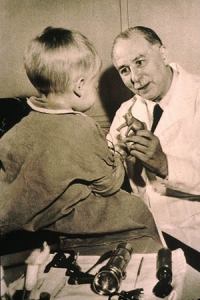
Sydney Farber
Sydney Farber from the Infants Hospital and Children’s’ Hospital, Boston, described the gradual recognition in the literature of a group of infants with coeliac disease who also had pancreatic lesions. He suggested, as had Wolman in 1942 and others, that previously Parmalee (1935) had made this clear distinction when reviewing coeliac children with pancreatic lesions. Farber postulated CF was a generalised disease – obstruction by thick mucus – “More important than infection is the obstruction (in the airways) caused by the tenacious mucus comparable in consistence with the viscid pancreatic juice. Inspissation of secretions and dilatation of glandular structures of the same general character as these (pancreatic) alterations in the acini and small ducts of the pancreas are found at autopsy on these patients in the glands of the trachea, bronchi, duodenum, gall bladder and intestinal tract”. Farber is credited with introducing the term “mucoviscidosis” (Farber 1942 above) perhaps, according to Douglas Holsclaw, influenced by his clinical colleague Harry Shwachman.
1944 Howard PJ. Familial character of fibrocystic disease of the pancreas. Am J Dis Child 1944; 68:330-332.
Philip Howard of Detroit reviewed the previous twelve instances of fibrocystic disease of the pancreas where a familial occurrence had been reported including instances where both or only one of twins had been affected. He reported an unusual number of infant deaths in two families in which proven CF existed and suggested the family furnished an instance of heterozygous inheritance (see Andersen and Hodges, 1946 below).
This is the first suggestion that CF was an inherited disorder – later this was established by Andersen and Hodges (1946 below).
1944 Menten ML, Middleton TO. Cystic fibrosis of the pancreas: report of 18 proved cases. Am J Dis Child 1944; 67:355-359.
Another paper based on a search through previous paediatric autopsies revealed 18 cases of CF from The Children’s Hospital, Pittsburgh; all had diffuse definite dilatation of the pancreatic acini and associated pneumonia. The authors state that radiological examination of the lungs showed a remarkable similarity in the unusual enlargement of the hilar shadows and a bilateral shadow decreasing to the periphery and suggest this as a diagnostic feature. Three had bronchoscopy during life – in one showing a normal trachea and in two reddened thickened mucous membrane containing thick mucopurulent material. This is the first mention of the bronchoscopic appearances seen in cystic fibrosis.
1944 Philipsborn HF Jr, Lawrence G, Lewis KC. The diagnosis of fibrocystic disease of the pancreas based upon 26 proved cases. J Pediatr 1944; 25:284-298.
Yet another retrospective review from Chicago of previous paediatric autopsies to identify those with characteristic pancreatic findings of cystic fibrosis. The clinical histories and pathology findings in 26 proven cases of CF since 1938 were reviewed noting that the diagnosis had seldom been made in life. The characteristic pancreatic findings of CF were present in 3.5% of all the children who had autopsies at the Children’s Memorial Hospital, Chicago. The authors suggested that the antemortem diagnosis of this not-so-uncommon condition can be facilitated by realising the various forms in which the disease manifests itself and by the judicious use of laboratory procedures including vitamin A absorption curves, duodenal drainage after intravenous secretin, mentioning that Ivy (Am J Dig Dis & Nutr 1936; 3:677) had noted reduced duodenal enzyme concentrations after secretin stimulation was significant. There is considerable detail including illustrations of the squamous metaplasia of the respiratory epithelium (figure 9) considered, by Andersen and others, to be related to vitamin A deficiency and a factor in perpetuating the respiratory infections.
1945 Baggenstoss AH, Kennedy RLJ. Fibrocystic disease of the pancreas: Study of 14 cases. Am J Clin Path 1945; 15:64-70.
Another report of 14 infants with cystic fibrosis identified by review of previous autopsies performed over the past 18 years at the Mayo Clinic. Patients were classified into meconium ileus (1), respiratory (8) and coeliac (5). The pancreatic histology was typical of CF and the mean age at death was 8.5 months. In discussing the suggested possible causes (vitamin A deficiency, viral infection, and abnormal pancreatic secretion and obstruction of the pancreatic duct) they conclude that “the possibility that abnormally thick secretion causes intrinsic obstruction in the acini and small ducts must be seriously considered”
1946 Wigglesworth FW. Fibrocystic disease of the pancreas. Am J Med Sci 1946; 246:351.
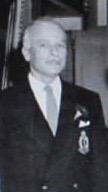
F W Wigglesworth
This paper lent some support to Farber’s theory that CF was a systemic disorder characterised by the production of an abnormally viscous secretion with secondary effects in many organs. The author surveyed the literature and noted that the secretions found in the pancreas and the mucous glands did not appear to be the same. Wigglesworth concluded that it was not necessary to attribute too much importance to the pancreatic lesions as a cause of the general changes (as was still suggested as a possibility by Dorothy Andersen) and that Farber’s theory of widespread involvement of mucus secreting glands was perhaps the most important of theories of aetiology but still required to be proved.
1946 Bodian M. Fibrocystic disease of the pancreas. Arch Dis Child 1946; 21:179.
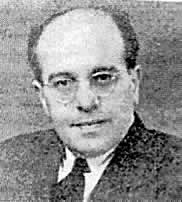
Martin Bodian
Martin Bodian was pathologist at the Hospital for Sick Children, Great Ormond Street, London. In this first short report on CF to a meeting of the British Paediatric Association, Bodian reviewed 30 children with CF seen at the Hospital for Sick Children, Great Ormond Street, London between 1943, when the first case there was diagnosed by Donald Patterson, and 1946.
Bodian also suggested that there was evidence for CF being a pluri-glandular disease with widespread abnormal secretions which inspissates in the pancreatic ducts and acini followed by atrophy and fibrosis. The measurement of trypsin in the duodenal contents was the most useful investigation. Clinically the patients were grouped as neonatal intestinal obstruction (3 cases), pneumonia in infancy (13) and coeliac syndrome (14). The details of the patients are included in his 1952 book (Bodian, 1952 below).
1949 Zuelzer WW, Newton WA. The pathogenesis of fibrocystic disease of the pancreas: a study of 36 cases with special reference to pulmonary lesions. Pediatrics NY 1949; 4:53-69. [PubMed]
Autopsy details of 36 children with CF are described from Detroit. In contrast to Andersen’s belief, they found no evidence for a primary nutritional factor in the genesis of the pulmonary changes. Squamous cell metaplasia previously considered to be related to vitamin A deficiency, was found in the trachea and bronchi in only 15 of the 28 cases in the respiratory group and was never present outside the respiratory tract. “The plugging of the bronchi and bronchioles with secretions was the earliest change observed and was invariably associated with emphysema and atelectasis. The bronchial walls remained intact, inflammatory changes were as yet absent and no squamous cell metaplasia of the respiratory epithelium was found.”
These findings tended to support the theory developed by Farber of the basic pathologic process being an anomaly of secretory function involving a number of organs – respiratory tract, intestine and biliary system. Nutritional deficiencies were considered to play only a secondary, though clinically very important, role. Incidentally three negro children were included in this series.
The authors state -”Our findings seem conclusive evidence that the involvement of the respiratory tract is an integral part of the disease which develops parallel with, not secondary to, the nutritional failure and depends on a basic abnormality of secretory processes predisposing to secondary infection” – a clear repudiation of Andersen’s vitamin A theory of pathogenesis and, as it turned out, an accurate prediction.
Dr Richard Boucher, of Chapel Hill North Carolina, is the champion of the low salt theory of pathogenesis. Low chloride secretion and excessive sodium absorption due to defective CFTR, in the airway epithelial cells, results in reduced airway surface liquid, interfering with removal of bacteria and other foreign substances – hence the predisposition to infection and difficulty clearing infected material. Speaking in London in 2007, Richard Boucher said he regards this as his favourite paper on cystic fibrosis in the literature!
1955 Allen RA, Baggenstoss AH. Pathogenesis of fibrocystic disease of the pancreas: study of ducts by serial sections. Am J Path 1955; 31:337-351. [PubMed]
The authors note current theories of pathogenesis are 1) vitamin A deficiency 2) imbalance of sympathetic nervous system 3) altered secretions of the glandular structures including the pancreas 4) inflammation 5) congenital atresia or stenosis of the pancreatic duct. They consider that their detailed histological findings lend support to the theory that the fundamental defect lies in maldevelopment of the pancreatic duct system.
A pertinent comment on this paper by J M Craig was that the authors ignored the considerable clinical and pathological evidence of involvement of other organ systems. This paper also emphasises the fact that, at the time, the cause was still totally obscure other than the condition was inherited in a Mendelian recessive manner.
1962 Andersen DH. Pathology of cystic fibrosis. Ann NY Acad Sci 1962; 93:500-517.
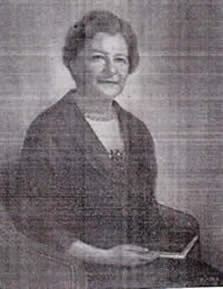
Dorothy Andersen
In this publication Dorothy Andersen reported that the lungs of CF infants were normal at birth. Others agreed that the lungs were “essentially normal” at birth (Zuelzer WW & Newton WA. Pediatrics 1949; 4:53-59). [PubMed]
However, others later found that there is an accumulation of mucin in the tracheobronchial glands of the fetus with CF even in the second trimester (Ornoy A et al. Am J Med Genet 1987; 28:935-947. [PubMed] ); and in the post natal period, even before infection occurs, changes are present in the submucosal glands (Oppenheimer EH, Esterly JR. Perspect Pediatr Pathol 1975; 2:241-278.[PubMed] ). Under four months of age there is some slight dilatation of the acini of the tracheal submucosal glands but gland development and architecture are normal (Sturgess J, Imrie J. Am J Pathol 1982; 106:303-311.[PubMed] ).
Despite these findings, which lead to very slight hyperinflation of the lungs, for practical purposes the respiratory function is normal and can be maintained in a stable state with little of no deterioration for many years provided chronic infection can be prevented by early diagnosis, careful microbiological monitoring and aggressive antibiotic treatment.
1962 Esterly JR, Oppenheimer EH. Observations in cystic fibrosis of the pancreas. I. The gallbladder. Bull Johns Hopkins Hosp 1962; 110:247-55. [PubMed]
First description of gall bladder abnormalities noted at autopsy that were present in 24 of 72 people with cystic fibrosis. “The cystic duct may be atretic or stenotic from inspissated mucus or mucosal hyperplasia. Mucus distends the gallbladder epithelial cells and fills the lumen with a colourless secretion. The gallbladder may atrophy or persist as a thin walled cyst lined with flattened mucosa”. Radiological appearances of the gall bladder and bile ducts had been reported by Jones et al, 1958 (above).
1963 Parkins RA, Eidelman S, Rubin CE, Dobbins WO III, Phelps PC. The diagnosis of cystic fibrosis by rectal suction biopsy. Lancet 1963; 38:851-6. [PubMed]
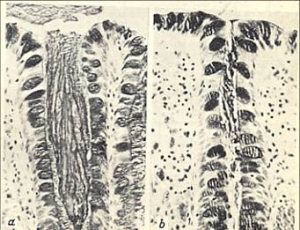
Rectal mucosa- left cystic fibrosis ; right normal
An interesting paper by workers with extensive experience in rectal biopsy. The histological picture was characteristic of CF in many patients. When the histological picture of rectal “mucosis” is present it is specific for CF as shown here (figure 12) and it cannot be confused with any other rectal condition. It was not clear as to the proportion of cases of CF could be diagnosed with certainty – six of 11 patients with CF examined in this study showed definite diagnostic changes. Understandably, rectal biopsy never became popular as an additional diagnostic aid for CF; although ion transport abnormalities in the rectal mucosa were described in number of later studies (Veeze et al, Gatroenterology 1981; 101:398-403; Hardcastle et al, 1991 below).
1964 Freye HB, Kurtz SM, Spock A, Capp MP. Light and electron microscopic examination of the small bowel of children with cystic fibrosis. J Pediatr 1964; 64:575-579. [PubMed]
Twenty one duodenal/jejunal mucosal biopsies were obtained from children with CF and showed normal villi and cell structure but the surfaces were covered by “a coarse fibrillar substance probably mucus” in those children who had steatorrhoea but not from the one patient that had normal fat absorption. The findings were considered to support the concept of Dische that mucus may contribute to the absorptive defect (Dische Z et al. Pediatrics 1959; 24:74)
These were early days for per oral jejunal biopsy in children and this was the first large study in children with cystic fibrosis. Earlier di Sant’Agnese had observed that “the histological picture on peroral biopsy is apparently normal as might be expected” (di Sant’Agnese et al. Rev Nutr Res 1961; 22:29). However, the present findings did not carry matters forward a great deal. My impression was that the intestinal villi were unusually tall in the few children with CF whom we biopsied to exclude coeliac disease.
1967 Reid L, De Haller R. The bronchial mucous glands – their hypertrophy and change in intracellular mucus. Mod Prob Pediatr 1967; 10:195-199. [PubMed]
Lynne Reid was a prominent UK researcher (Reid, 1961 details above). In 1981 she reviewed her work over the decade at the Minnesota CF meeting (Bronchial mucus and its glycoproteins in cystic fibrosis. In: Warwick WJ (Ed.). 1000 Years of Cystic Fibrosis – Collected papers. University of Minnesota. 1981:179-184). Although a great deal of work was carried out on the various physico-chemical properties of mucus, none appears to have had a significant effect on either the treatment or the further understanding of the basic defect – except perhaps that the increased viscosity was due to the high DNA content which was eventually improved by the use of genetically engineered rhDNase (Pulmozyme) (Shak et al, 1990 below; Fuchs et al, 1994 below).
1967 Reid L, De Haller R. The bronchial mucous glands – their hypertrophy and change in intracellular mucus. Mod Prob Pediatr 1967; 10:195-199. [PubMed]
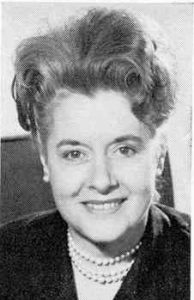
Lynn Reid
Lynne Reid was a prominent UK researcher (Reid, 1961 details above). In 1981 she reviewed her work over the decade at the Minnesota CF meeting (Bronchial mucus and its glycoproteins in cystic fibrosis. In: Warwick WJ (Ed.). 1000 Years of Cystic Fibrosis – Collected papers. University of Minnesota. 1981:179-184). Although a great deal of work was carried out on the various physico-chemical properties of mucus, none appears to have had a significant effect on either the treatment or the further understanding of the basic defect – except perhaps that the increased viscosity was due to the high DNA content which was eventually improved by the use of genetically engineered rhDNase (Pulmozyme) (Shak et al, 1990 below; Fuchs et al, 1994 below).
1968 Esterly J, Oppenheimer E. Observations in cystic fibrosis of the pancreas I: The Gallbladder. Bull Johns Hopkins Hosp 1968:110:247-254.
Reported blockage of the cystic duct by white mucous material. Previous reports on the gall bladder by Jones et al, 1958 (above) and Esterly & Oppenheimer, 1962 (above).
1968 Esterly JR, Oppenheimer EH. Cystic fibrosis of the pancreas: structural changes in peripheral airways. Thorax 1968; 23:670-675. [PubMed]
A detailed report of autopsy findings of 84 patients with CF. There was widespread dilatation of respiratory bronchioles and alveolar ducts in 29 but significant parenchymal destruction in only three patients.
John Esterly and Ella Oppenheimer of Johns Hopkins Baltimore made numerous contributions to the knowledge of the pathology of cystic fibrosis.

Ella Oppenheimer
1972 Oppenheimer EH. Glomerular lesions in cystic fibrosis: possible relation to diabetes mellitus, acquired cyanotic heart disease and cirrhosis of the liver. Hopkins Med J 1972; 131:351-366. [PubMed]
Glomerular changes were noted at autopsy in four of the five children with CF who also had diabetes mellitus. Other factors were involved but “since cyanotic heart disease, diabetes mellitus and biliary cirrhosis are important complications of cystic fibrosis, it is apparent that greater numbers of cystic fibrosis children with renal complications will be found and that with longer survival renal insufficiency may become an important part of the cystic fibrosis syndrome”.
A prophetic statement as indeed this proved to be the case and diabetes mellitus proved a serious and increasing problem as survival increased. Also a variety of nephrotoxic drugs such as aminoglycosides and colomycin were used repeatedly over many years (Bertenshaw C. Watson AR. Lewis S. Smyth A. Survey of acute renal failure in patients with cystic fibrosis in the UK. Thorax 2007; 62:541-545).
1973 Oppenheimer EH, Esterly JR. Cystic fibrosis of the pancreas. Morphologic findings in infants with and without diagnostic pancreatic lesions. Arch Pathol Lab Med 1973; 96:149 – 154. [PubMed]
It was suggested that some infants with CF may have normal pancreatic morphology and also it had been suggested that some infants with clinical meconium ileus did not have cystic fibrosis (Rickham PP. Intraluminal intestinal obstruction. Prog Pedaitr Surg 1971; 2:73-82). In this series ten of 37 infants with meconium ileus did not have typical changes of CF in the pancreas but other anatomical lesions were present compatible with a diagnosis of CF.in 34 of the 37 cases and the changes in the other 3 were suggestive. The authors suggest that meconium ileus is always a manifestation of cystic fibrosis although there is variation in organ involvement.
Since the Thirties histological changes in the pancreas were the means of identifying CF as a distinct entity from coeliac disease but these studies show the changes were very variable. However, subsequent studies from Toronto showed that pancreatic abnormalities were always present when detailed quantitative microscopy techniques were used (Imrie JR et al, Am J Path 1979; 95: 697-707; Sturgess JM. 1984 below).
1975 Oppenheimer EH, Esterly JR. Pathology of cystic fibrosis. Review of the literature and comparison with 146 autopsied cases. Perspect Pediatr Pathol 1975; 2:241-278.[PubMed]
A classic detailed review of current knowledge of the pathology of cystic fibrosis and a major source of references on the pathology of the condition up to that time and since, for present day autopsy data in children with CF is now very rare as it is unusual for children with CF to die.
Ella Oppenheimer and John Esterly made major contributions to the pathology of CF with numerous publications on the subject. While attributing the term “mucoviscidosis” to Farber (1944 above), they prefer the term “cystic fibrosis of the pancreas” as the condition is not restricted to the mucus-secreting glands. Three basic observations on the pancreatic changes are there is a spectrum of changes, diagnostic lesions may be absent irrespective of age and there is usually a direct correlation with age and severity of the lesions. Focal biliary cirrhosis was found in 19% of this series. In newborns there is hyperplasia and obstruction of the submucosal glands of the trachea and major bronchi before any infection has occurred.
A magnificent paper – apart from the incorrect spelling of Dorothy Andersen’s name throughout (as Anderson!). But they are not alone – one distinguished editor of a leading paediatric journal is also guilty!
1977 Geller A, Gilles F, Shwachman H. Degeneration of the fasciculus gracilis in cystic fibrosis. Neurology 1977; 27:185-187. [PubMed]
Nineteen percent of 106 of the spinal cords of patients dying with CF after the age of five showed posterior column degeneration. None of the patients had been anaemic or had spinocerebellar degeneration. Nutritional, toxic or hereditary factors were considered as possibly responsible. This possibility seems to have received little attention in recent years.
Later Cavalier SJ & Gambetti P.(Neurology 1981; 31:714-718.) [PubMed] reviewed 43 autopsy cases of CF and found 66% had developed dystrophic axons; neuroaxonal dystrophy correlated with the duration of the disease. Demyelination of the fasciculus gracilis occurred in 11%. They said the neuropathology of CF resembled that of vitamin E deficiency in animals but vitamin E replacement had failed to prevent the neuropathology changes in these patients.
1979 Vawter GF, Shwachman H. Cystic fibrosis in adults: an autopsy study. Pathol Ann 1979; 14 Pt 2:357-382. [PubMed]
In this population, the most characteristic abnormalities recognized by the pathologist were focal biliary cirrhosis, distinctive obstructive lesions of the male genital tract, prolonged Staphylococcal or Pseudomonas colonization of respiratory secretions, and obstructive bronchopulmonary disease. some form of pancreatic atrophy was usually present.
1982 Chow CW, Landau LI, Taussig LM. Bronchial mucus glands in newborn with cystic fibrosis. Eur J Pediatr 1982; 139:240-243. [PubMed]
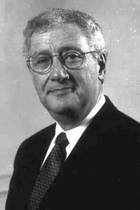
Lynn Taussig
Bronchial glands of 21 CF infants who died aged less than 3 weeks from meconium ileus were not different from those of 28 controls. Absence of mucus gland hyperplasia at birth suggests that mucous obstruction is not primarily responsible for the susceptibility to infection.
A vast amount of research had been done over the previous years to determine intrinsic abnormalities of mucus caused by the basic defect without any definite repeatable conclusions. However, this paper was useful in suggesting that intrinsic abnormalities in the structure of CF mucus were probably not a major factor in the pathogenesis of the lung infections. The findings of Knowles et al 1981 (above) supported the view that salt and water abnormalities leading to dehydration of the airway secretions were a more likely reason for alteration in the viscosity of the airway secretions predisposing to chronic infection than were intrinsic abnormalities of the mucus.
1984 Sturgess JM. Structural and developmental abnormalities of the exocrine pancreas in cystic fibrosis. J Pediatr Gastroenterol Nutr 1984; 3 Suppl 1:S55-66. [PubMed]

Jennifer Sturgess
Early signs of a deficiency in exocrine pancreatic tissue at 32-38 weeks post-conceptional age suggest that there is a lack of normal maturation of pancreatic exocrine tissue that occurs in utero, with a degenerative process supervening after birth. The volumes of the acinar and duct lumen are markedly increased, up to 10 fold normal volume in CF subjects. The diagnosis of CF within the first few months of life is difficult when based on conventional or subjective pancreatic histology. But by quantitative microscopy of the pancreas as described by Jennifer Sturgess (1944-2009), the distinguished paedaitric pathologist from Toronto, an objective approach is available that clearly separates CF from control subjects. In this retrospective survey, 93% of CF infants were discriminated from normals; only 2 of 30 cases (7%) were not clearly differentiated from controls.
Earlier studies had reported some CF infants had normal pancreatic histology (Oppenheimer & Esterly, 1973 above).
2001 Iwasa S, Fujiwara M, Nagata M, Watanabe T. Three autopsied cases of cystic fibrosis in Japan. Pathol Internat 2001; 51:467-472. [PubMed]
The incidence of CF is very low in the Japanese. All three patients initially developed meconium ileus, and hepatobiliary and pancreatic changes became more severe as age increased. None had the DeltaF508 mutation. The authors reviewed 22 Japanese autopsied cases of CF in the literature. They suggested that the high incidence of meconium ileus in Japanese CF patients may relate to a clinically severe phenotype and reflect a different genetic background between Caucasians and Japanese. The incidence of CF in Japanese had been estimated previously at 1:350,000 considering 104 reported cases in 1997 (Yamashiro Y et al, 1997; 24:544-547. [PubMed]).
2007 Marcorelles P. Montier T. Gillet D. Lagarde N. Ferec C. Evolution of CFTR protein distribution in lung tissue from normal and CF human fetuses. Pediatr Pulmonol 2007; 42:1032-1040. [PubMed]. The distribution of CFTR protein progressively increased from 10 weeks of gestation (WG) to mid-gestation, but thereafter decreased until term. The CFTR protein was first detected in the cytoplasm of undifferentiated epithelial cells. Before mid-gestation, the immunostaining was strongly positive in bronchi, in sub-mucosal glands, and in lung parenchyma. Then, it became localized to the apical zone of the epithelial cells. This pattern correlated with differentiation during the second half of gestation. The main difference observed between normal and CF fetuses was a 3-week delay in detectability of the CFTR protein expression in the latter until 15 weeks of gestation. These results support the hypothesis of an early functional change. Abnormal fetal lung CFTR protein regulation could give rise to a predisposition to the post-natal inflammatory changes of the airways that characterize CF disease.
2007 Verhaeghe C, Delbecque K, de Leval L, Oury C, Bours V. Early inflammation in the airways of a cystic fibrosis foetus. J Cyst Fibros 2007; 6:304-308. [PubMed]
In people with CF, inflammation is often considered to be secondary to chronic infections. In the present study, there were increased levels of pro-inflammatory proteins in the lungs of a CF foetus compared to the lungs of two non-CF fetuses. The authors consider their findings suggest the existence of an early intrinsic pro-inflammatory state in cystic fibrosis airways.
It seems clear that inflammation occurs in CF and the airways react excessively when infection occurs. In this study the implication is that infection is not required to initiate inflammation. Probably difficult to come to any conclusions on this one report although it does provide different evidence.
Scambler T, Jarosz-Griffiths HH, Lara-Reyna S, Pathak S, Wong C, Holbrook J, Martinon F, Savic S, Peckham D, McDermott MF. ENaC-mediated sodium influx exacerbates NLRP3-dependent inflammation in cystic fibrosis. Elife. 2019 Sep 18;8. pii: e49248. doi: 10.7554/eLife.49248. Free PMC Article [Pubmed]
Cystic Fibrosis (CF) is a monogenic disease caused by mutations in the cystic fibrosis transmembrane conductance regulator (CFTR) gene, resulting in defective CFTR-mediated chloride and bicarbonate transport, with dysregulation of epithelial sodium channels (ENaC). These changes alter fluid and electrolyte homeostasis and result in an exaggerated proinflammatory response driven, in part, by infection.
The authors tested the hypothesis that NLRP3 inflammasome activation and ENaC upregulation drives exaggerated innate-immune responses in this multisystem disease. They identify an enhanced proinflammatory signature, as evidenced by increased levels of IL-18, IL-1β, caspase-1 activity and ASC-speck release in monocytes, epithelia and serum with CF-associated mutations; these differences were reversed by pretreatment with NLRP3 inflammasome inhibitors and notably, inhibition of amiloride-sensitive sodium (Na+) channels. Overexpression of β-ENaC, in the absence of CFTR dysfunction, increased NLRP3-mediated inflammation, indicating that dysregulated, ENaC-dependent signalling may drive exaggerated inflammatory responses in CF. These data support a role for sodium in modulating NLRP3 inflammasome activation.
Leeds Institute of Rheumatic and Musculoskeletal Medicine, University of Leeds, Leeds, United Kingdom
Adult Cystic Fibrosis Unit, St James’ University Hospital, Leeds, United Kingdom.
Forrest OA, Chopyk DM, Gernez Y, Brown MR, Conrad CK, Moss RB, Tangpricha V, Peng L, Tirouvanziam R. Resistin is elevated in cystic fibrosis sputum and correlates negatively with lung function. J Cyst Fibros. 2019 Jan;18(1):64-70. doi: 10.1016/j.jcf.2018.05.018. Epub 2018 Jun 21.[Pubmed]
Resistin is an immune-metabolic mediator that is elevated in several inflammatory disorders. A ligand for Toll-like receptor 4, resistin modulates the recruitment and activation of myeloid cells, notably neutrophils. Neutrophils are major drivers of cystic fibrosis (CF) lung disease, in part due to the release of human neutrophil elastase- and myeloperoxidase-rich primary granules, leading to tissue damage. The authors assessed the relationship of resistin to CF lung disease.
Plasma resistin levels were only marginally higher in CF than in healthy control subjects. By contrast, sputum resistin levels were very high in CF, reaching 50-100 fold higher levels than in plasma. Among CF patients, higher plasma resistin levels were associated with allergic bronchopulmonary aspergillosis, and higher sputum resistin levels were associated with CF-related diabetes. Mechanistically, in vitro release of neutrophil primary granules was concomitant with resistin secretion. Overall, sputum resistin levels were negatively correlated with CF lung function, independently of other variables (age, sex, and genotype).
Our data establish relationships between resistin levels in the plasma and sputum of CF patients that correlate with disease status, and identify resistin as a novel mechanistic link between neutrophilic inflammation and lung disease in CF.
Dr O A Forrest is in the Dept. of Pediatrics, Emory University, Atlanta.
[Resistin, also known as adipose tissue-specific secretory factor (ADSF) or C/EBP-epsilon-regulated myeloid-specific secreted cysteine-rich protein (XCP1), is a cysteine-rich adipose-derived peptide hormone that in humans is encoded by the RETN gene. It was discovered in 2001 by the group of Dr Mitchell A. Lazar from the University of Pennsylvania School of Medicine. It was called “resistin” because of the observed insulin resistance in mice injected with resistin]
Muraglia KA, Chorghade RS, Kim BR, Tang XX, Shah VS, Grillo AS, Daniels PN, Cioffi AG, Karp PH, Zhu L, Welsh MJ, Burke MD.Small-molecule ion channels increase host defences in cystic fibrosisairway epithelia.Nature. 2019 Mar; 567(7748):405-408. doi: 10.1038/s41586-019-1018-5. Epub 2019 Mar 13.[Pubmed]

Martin D Burke, Katrina Muraglia,
& Rajeev Choghade
Loss-of-function mutations in the cystic fibrosis transmembrane conductance regulator (CFTR) compromise epithelial HCO3– and Cl– secretion, reduce airway surface liquid pH, and impair respiratory host defences in people with cystic fibrosis. Here the authors report that apical addition of amphotericin B, a small molecule that forms unselective ion channels, restored HCO3– secretion and increased airway surface liquid pH in cultured airway epithelia from people with cystic fibrosis. These effects required the basolateral Na+, K+-ATPase, indicating that apical amphotericin B channels functionally interfaced with this driver of anion secretion. Amphotericin B also restored airway surface liquid pH, viscosity, and antibacterial activity in primary cultures of airway epithelia from people with cystic fibrosis caused by different mutations, including ones that do not yield CFTR, and increased airway surface liquid pH in CFTR-null pigs in vi
Gitte Berkers , Peter van Mourik, Annelotte M Vonk, Evelien Kruisselbrink, Johanna F Dekkers, Karin M de Winter-de Groot, Hubertus G M Arets, Rozemarijn E P Marck-van der Wilt, Jasper S Dijkema, Maaike M Vanderschuren, Roderick H J Houwen, Harry G M Heijerman, Eduard A van de Graaf, Sjoerd G Elias, Christof J Majoor, Gerard H Koppelman, Jolt Roukema, Marleen Bakker, Hettie M Janssens, Renske van der Meer, Robert G J Vries, Hans C Clevers, Hugo R de Jonge, Jeffrey M Beekman, Cornelis K van der Ent Rectal Organoids Enable Personalized Treatment of Cystic Fibrosis. Cell Rep 2019 Feb 12;26(7):1701-1708.e3.doi: 10.1016/j.celrep.2019.01.068. Free article [Pubmed]

Gitte Berkers
In vitro drug tests using patient-derived stem cell cultures offer opportunities to individually select efficacious treatments. Here, we provide a study that demonstrates that in vitro drug responses in rectal organoids from individual patients with cystic fibrosis (CF) correlate with changes in two in vivo therapeutic endpoints. We measured individual in vitro efficaciousness using a functional assay in rectum-derived organoids based on forskolin-induced swelling and studied the correlation with in vivo effects. The in vitro organoid responses correlated with both change in pulmonary response and change in sweat chloride concentration. Receiver operating characteristic curves indicated good-to-excellent accuracy of the organoid-based test for defining clinical responses. This study indicates that an in vitro assay using stem cell cultures can prospectively select efficacious treatments for patients and suggests that biobanked stem cell resources can be used to tailor individual treatments in a cost-effective and patient-friendly manner.
Gitte Berkers is a PhD student in the Department of Pediatric Pulmonology, Wilhelmina Children’s Hospital, University Medical Center Utrecht, Utrecht University, 3584 EA Utrecht, the Netherlands.
Thus, unselective small-molecule ion channels can restore host defences in cystic fibrosis airway epithelia via a mechanism that is independent of CFTR and is therefore independent of genotype.
Dr Katrina A Muraglia is in the Department of Biochemistry, University of Illinois at Urbana-Champaign, Urbana, IL, USA. Dr Rajeev Chorghade is a graduate student. Dr Martin D Burke is leader of the study group and Professor of Chemistry and Associate Dean for Research at the Carle Illinois College of Medicine
Sophie Gohy, Alexandra Moeremans, Charles Pilette, Amandine Collin. Immunoglobulin A Mucosal Immunity and Altered Respiratory Epithelium in Cystic Fibrosis. Cells 2021 Dec 20;10(12):3603.doi: 10.3390/cells10123603 Free PMC article [Pubmed]

Sophie Gohy
The respiratory epithelium represents the first chemical, immune, and physical barrier against inhaled noxious materials, particularly pathogens in cystic fibrosis. Local mucus thickening, altered mucociliary clearance, and reduced pH due to CFTR protein dysfunction favour bacterial overgrowth and excessive inflammation. We aimed in this review to summarize respiratory mucosal alterations within the epithelium and current knowledge on local immunity linked to immunoglobulin A in patients with cystic fibrosis.
-There are detailed colour figures in the free PMC article
Dr Sophie Gohy is with the Department of Pneumology, Cliniques Universitaires Saint-Luc, Avenue Hippocrate 2, 1200 Brussels, Belgium;Pole of Pneumology, ENT and Dermatology, Institute of Experimental & Clinical Research, Université Catholique de Louvain (UCLouvain), 1200 Brussels, Belgium; Cystic Fibrosis Reference Center, Cliniques Universitaires Saint-Luc, 1200 Brussels, Belgium.
